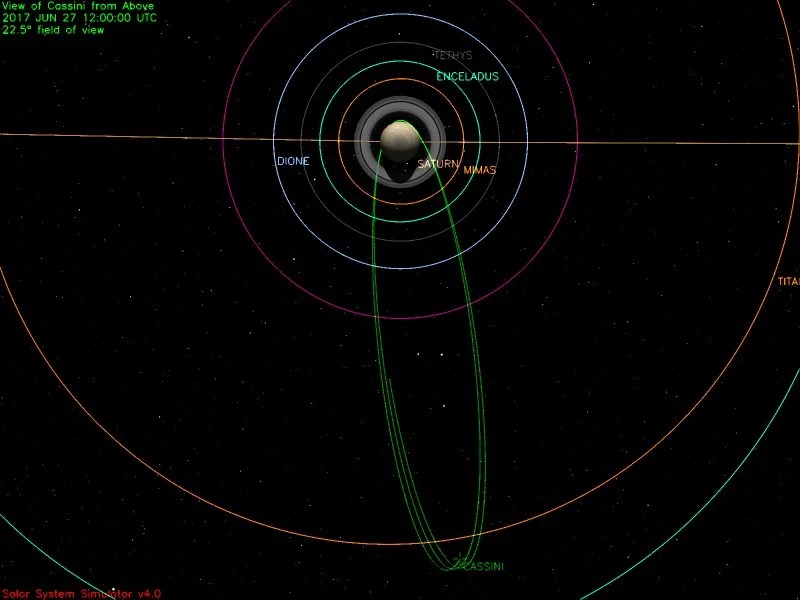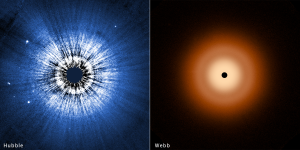One of the best things about Cassini is that its on-board science instruments can be fine-tuned. The Cosmic Dust Analyzer's (CDA) science team, in Germany, decided to adjust the instrument's settings this week. Based on their experience during the previous "proximal" passages between Saturn's rings and atmosphere, they created a string of 39 commands that would set the instrument to make the best possible observations during the next proximal plunge, coming up on June 29. Details about this direct-sensing instrument may be found here: https://go.nasa.gov/29COVlu.
The commands were designed to accomplish several things. First, they would adjust voltages on the instrument's internal grids, so the instrument could focus on making spectral measurements of the particles it ingests. Also, the instrument would articulate its aperture to the necessary angle. Test pulses would confirm that the instrument's amplifiers were in the necessary ranges of sensitivity. The commands would also set the instrument's data-collection rate to 4 kilobits per second, thus making sure all ring-particle impacts would be sensed.
Wednesday, June 21 (DOY 172)
Writers, vloggers, photographers, educators, students, artists and others who use social media to engage specific audiences are encouraged to apply for special access to Cassini's Grand Finale event in mid-September. Details are available here: /news/13075/witness-cassinis-finale-at-saturn-live-from-jpl.
Thursday, June 22 (DOY 173)
The Composite Infrared Spectrometer (CIRS) turned and looked at Saturn's large icy moon Dione for 3.5 hours today. The Imaging Science Subsystem (ISS), the Visible and Infrared Mapping Spectrometer (VIMS), and the Ultraviolet Imaging Spectrograph (UVIS) – all the other Optical Remote-Sensing (ORS) instruments – rode along to make observations as well. CIRS's goal was to measure Dione's surface emissivity at thermal-infrared wavelengths, which hold clues to the composition and structure of that moon's regolith.
A summertime view of Saturn’s largest moon Titan was selected as today's Astronomy Picture of the Day: https://apod.nasa.gov/apod/ap170622.html.
Friday, June 23 (DOY 174)
Beginning late today, the spacecraft trained its High-Gain Antenna dish on the distant Earth. It then accurately tracked our planet for a total of 28 hours. Accordingly, the Radio Science Subsystem (RSS) team had Cassini power on its S-band (2 GHz) and Ka-band (32 GHz) radio transmitters, which directed their beams of energy out the HGA along with the main communications beam at X-band (8 GHz). The result was a high-precision measurement of Saturn's gravitation, which will be analyzed to reveal deviations from spherical symmetry. This in turn will show how the atmosphere's density varies with depth, and how surface winds influence lower layers in Saturn. The mass of the ring system can also be determined. Cassini must be very close to Saturn to feel the weakest gravity perturbations, and this is one reason why the current “Grand Finale” orbits are unique and important. While keeping the HGA pointed to Earth, prior to periapsis passage the spacecraft rolled to an attitude that also placed the Cosmic Dust Analyzer (CDA) in a favorable position to sample any stray ring particles.
As if gravity measurement and CDA observations weren't enough surrounding today's periapsis passage, the continuous radio signals from Cassini also probed Saturn's rings twice: once looking from inside the rings outward towards Earth (occultations with this geometry have never been attempted before), and then a few hours later from farther behind the planet (this is the "standard" RSS occultation geometry, which is also highly valuable).
These observations provided for characterization of ring asymmetry due to waves that are known to permeate the A and B rings, caused by phenomena such as resonant interaction with satellites and Saturn’s interior structure. Measurements of the rings by RSS and CDA, along with data from the optical instruments, also provide data for scientists to more accurately determine the rings' age.
Saturday, June 24 (DOY 175)
CIRS observed the dark side of Saturn's A ring at far-infrared wavelengths for five hours today, with the other ORS instruments riding along. In addition to studying ring-particle compositions, the observation was part of a campaign to compare the spectral properties of ices among different regions of Saturn’s rings and icy moons.
Cassini and Titan happened to come close to one another today, to a distance about the same as that from Earth to our own Moon. Starting today, ISS performed a total of 13.6 hours of high priority observations to study Titan’s clouds, which are of particular interest as northern summer sets in there; CIRS and VIMS rode along. Next, ISS and VIMS rode along while CIRS took control for 4.4 hours and scanned Titan’s northern hemisphere, mapping its temperature, and the atmosphere's gas concentrations.
In between Titan observations, UVIS turned towards Saturn and observed two stellar occultations, totaling 5.2 hours. Epsilon Orionis and then Zeta Orionis went behind Saturn’s atmosphere and then re-emerged. These occultation observations mapped the temperature and chemical constituents in Saturn's upper atmosphere and thermosphere.
Sunday, June 25 (DOY 176)
This week’s Titan observing wrapped up today with its final 4.3 hours devoted to observing clouds on the planet-like moon; VIMS rode along.
Monday, June 26 (DOY 177)
ISS turned and spent 7.7 hours observing Saturn's irregular moon Bebhionn, an object of about six kilometers diameter, which orbits Saturn in an inclined ellipse that reaches as far as 25.1 million km from the planet. It might have a binary or contact-binary nature. Bebhionn was named after the goddess of birth in early Irish mythology.
UVIS spent 4.7 hours observing the occultation of the blue star Kappa Orionis as it drifted behind Saturn's rings. This occultation was of particular interest because the point where the star appeared to reverse direction occurred in the B-Ring. This made for an ultra-fine-resolution observation that has not typically been possible until now (during the proximal orbits). Next, CIRS observed the far-infrared spectra of Saturn’s A and B rings, to learn about ring-particle composition.
The flight team held a Command Approval Meeting today for the file of CDA's fine-tuning commands. Representatives from each of the affected spacecraft subsystems and instruments voiced and signed their okays, and the file was approved for radiation to the spacecraft.
An image featured today shows Dawn on Saturn: /resources/17692.
Tuesday, June 27 (DOY 178)
UVIS observed the egress occultation of the bright blue star Beta Canis Majoris, as it rose out of Saturn’s atmosphere. This 1.1-hour stellar occultation mapped temperatures and chemical species in Saturn's thermosphere. Next, VIMS, UVIS, ISS and CIRS observed another stellar occultation by Saturn's rings. This one lasted 10.7 hours while the bright star Alpha Canis Majoris, also known as Sirius, probed the rings' radial structure and further constrained particle-size distributions.
Ten minutes after the Deep Space Network (DSN) station in Australia acquired Cassini's downlink, its 18-kilowatt transmitter was turned on, and the Realtime Operations team sent the approved CDA fine-tuning commands on their way. After a round-trip of 2 hours 31 minutes, telemetry confirmed that the commands had been received and were ready to take effect right before Cassini's eleventh proximal plunge on June 29.
The DSN communicated with and tracked Cassini on 11 occasions this week, using stations in California and Australia. The European Space Agency contributed ground antenna support three times from Australia and Argentina. A total of 58 individual commands were uplinked, and about 1,625 megabytes of science and engineering telemetry data were downlinked and captured at rates as high as 142,201 bits per second.
Wrap up:
Cassini is executing its set of 22 Grand Finale Proximal orbits, which have a period of 6.5 days, in a plane inclined 61.9 degrees from the planet's equatorial plane. Each orbit stretches out to an apoapsis altitude of about 1,272,000 km from Saturn, where the spacecraft's planet-relative speed is around 6,000 km/hr. At periapsis, the distance shrinks to about 2,500 km above Saturn's visible atmosphere (by comparison, Saturn is about 120,660 km in diameter), and the speed is around 123,000 km/hr.
The most recent spacecraft tracking and telemetry data were obtained on June 28 using the 70-meter diameter DSN station in Australia. The spacecraft continues to be in an excellent state of health with all of its subsystems operating normally except for the instrument issues described at http://saturn.jpl.nasa.gov/anomalies.
This illustration shows Cassini's path up to mid-day June 27: https://go.nasa.gov/2qCHH5s.
The countdown clock in Mission Control shows 79 days until the end of the Mission.
------------------------
This page offers all the details of the Mission's ending: <https://saturn.jpl.nasa.gov/mission/grand-finale/overview/>
------------------------
Milestones spanning the whole orbital tour are listed here:
<https://saturn.jpl.nasa.gov/mission/saturn-tour/tour-dates/>
------------------------
Information on the present position and speed of the Cassini spacecraft may be found on the "Present Position" page at:
<https://saturn.jpl.nasa.gov/mission/saturn-tour/where-is-cassini-now/>
------------------------
To unsubscribe from Cassini Spacecraft Updates or to subscribe with a different email address, visit:
<http://saturn.jpl.nasa.gov/news/mailinglistsignup/>
------------------------
For comments and questions, please contact Cassini Public Engagement at:
<http://saturn.jpl.nasa.gov/feedback/>
------------------------
This illustration shows Cassini's path up to mid-day June 27.



































